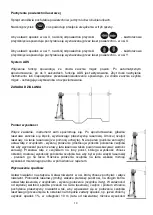
8
The laser plummet (top) defines a line perpendicular to the plane of the laser level, which
is used in all perpendicular works (building partitions, setting 90° angle, etc.).
Remote control
Features of NL301 / NL301G laser level can be controlled remotely using the remote control.
On the remote control panel there are 9 buttons that correspond to those included on the front
panel of laser level. The operating range of remote control is approximately 20 meters (depends
on the conditions on the site)
Checking the laser level
You should regularly check the following parameters of the laser level
setting a horizontal plane
cone error
setting a vertical plane
Checking and calibration of the horizontal and vertical planes is simple and in most cases can
be done by the user. Checking the cone error can be also done by the user, but this error can
be only removed by an authorized service center.
Checking the horizontal plane
1. Set the instrument about 30m from the wall so that the X-axis is perpendicular to the
wall and X direction a pointed to a wall.
2. Turn on the instrument and wait until it level automatically.
3. Place a sheet of paper on the wall. Mark the position of the laser beam (Ma) on the
sheet. Turn off the instrument.
4. Loosen the tripod fixing screw and rotate the instrument 180 °.
WARNING!
Be careful not to move the instrument while the head is spinning.
5. Turn on the instrument once again and wait until it level automatically.
6. Once again mark the position of the laser beam on the sheet (Mb).
7. Measure the distance between the marks Ma and Mb, if the distance is less than 6
mm calibration is not necesary, in other case please contact service center
8. Perform similar operations for the Y axis .
Checking the cone error
Please do this procedure after calibration of horizontal plane.
1. Set the laser centered between the walls distanced from each other of 30 m. Set the
instrument in the X or Y direction.
2. Mark the position of the laser beam on both walls.
3. Turn off the instrument and move it near to the of one of the walls (1 to 2 meters). Do not
change the orientation of the axes. Turn on the instrument.
4. Again, mark the position of the laser beam on the walls
5. Measure the distance between the marks on the walls.
6. If the difference in distance is less than 3 mm, it can be assumed that this error does not
occur.
Warning! If this error is more than 3m, you should contact the service center.





































